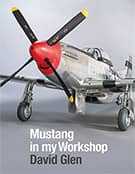Oleo strut supports
Friday, 30th May, 2014
My wing centre section and fuselage were now bolted together, but they were still demountable. All that would change once the balsa infill had been glued in along the wing root fillets, so it was crucial at this stage to make provision for mounting the main landing gear while the centre section spar was still accessible.
The methodology here is essentially that used successfully in both my Spitfire Mk I and P-51D models: I fabricated a pair of sturdy T-section brackets designed to bolt directly to the rear of the spar and to carry a 4-in. tubular stub designed to telescope into the oleo strut. I chose non-ferrous metals for this simply because they are easier to silver solder, and the simple arrangement I came up with is shown in the accompanying photographs.
Perhaps I should add here that, while my models strive to represent the original in all visible detail, I do make exceptions, and this is one of them. Sequestered in within the cramped confines of a narrow channel in the under-wing and almost totally hidden from view, the engineering required to replicate the complex pivot, pintle and locking arm arrangement of a Spitfire’s landing gear would be impractical, even if it were within my capabilities. So while I anticipate fully detailing the internal structure of the wheel wells and strut channels, I bow to practicality in this particular instance, where mechanical strength and durability are the prime considerations.
The pictures speak largely for themselves, except to say that I used 1/8-in. and 1/16-in. sheet brass scraps for the brackets and sturdy 5/8-in. o.d. brass tube with a wall thickness of around 1/16-in. Silver soldering of chunky metal parts is not difficult, but it requires scrupulous cleanliness of the adjoining surfaces, the correct flux and plenty of heat: two propane-butane hand torches and an old tin tray filled with charcoal did the job.
However, while the ‘engineering’ was simplicity itself, the geometry involved required great care. Viewed from the front, a Spitfire’s oleo struts are splayed by a modest but perceptible 2.5 degrees from the vertical and they have a pronounced forward rake. Both required very careful marking out and repeated checks during the pre-assembly stages. I drilled the brass parts for a couple of rivets here and there and I used my bench mill to slot the brass tube to create a tight friction fit with the bracket, and by these means held the assembly together during soldering.
Each bracket is attached to the airframe by three 6BA studs made captive in the hardwood main spar. Thus the assembly can be installed and removed again where necessary, albeit with difficulty since there is very little room within the strut channel to wield a spanner!






